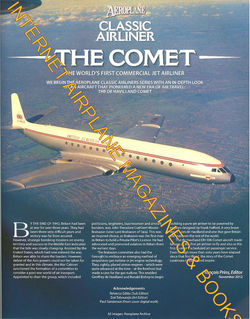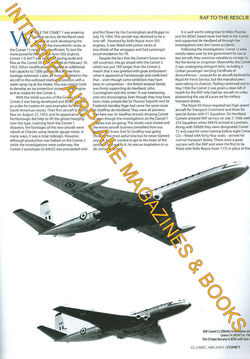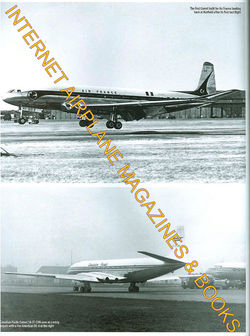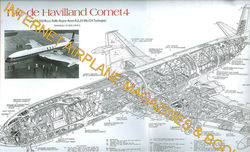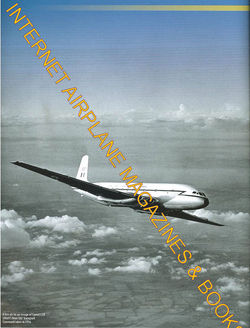CLASSIC AIRLINERS de
HAVILLAND COMET PIONEER JET AIRLINER BOAC AIR FRANCE RAF MEXICANA
AIRLINER COLOR
HISTORY
SOFTBOUND BOOK ***
LIKE NEW CONDITION **** 98 PAGES
THE WARTIME BRABAZON
COMMITTEE & THE POST-WAR BRITISH AIRLINER INDUSTRY
RATIONALIZING THE
AIRLINES
GEOFFREY de HAVILLAND
– GIFTED AVIATION PIONEER
BRITAIN’S LEAD IN GAS
TURBINE JET ENGINE TECHNOLOGY – SIR FRANK WHITTLE
BUILDING THE COMET
PROTOTYE
FLIGHT TESTING – TEST
PILOT JOHN CUNNINGHAM
DH COMET PRODUCTION
LINE ARCHIVES
PURE JET AIRLINER
SERVICE (BOAC & AIR FRANCE)
AIRLINER INTERIOR –
RARE COLOR ARTWORK
COMET PROBLEMS
MILITARY SERVICE
COMET 1 (CANADIAN
PACIFIC)
THE COMET 2E AND
COMET 3 DVELOPMENTS
COMET 4 (MALAYSIAN
AIRWAYS, BEA, BOAC, AEROLINEAS ARGENTINAS, MEXICANA, KUWIT AIRWAYS, UNITED ARAB
AIRLINES, DAN-AIR LONDON, CHANNEL AIRWAYS
END OF THE LINE
SURVIVING AIRFRAMES
CENTERFOLD CUTAWAY
DRAWING
----------------------------------------------------------------------------------------------------------------------------------
Additional Information from Internet Encyclopedia
The de
Havilland DH 106 Comet was the world's first production commercial
jetliner. Developed and manufactured by de Havilland at its Hatfield Aerodrome,
Hertfordshire, United Kingdom headquarters, the Comet 1 prototype first
flew on 27 July 1949. It featured an aerodynamically clean design with four de
Havilland Ghost turbojet engines buried in the wings, a pressurised fuselage,
and large square windows. For the era, it offered a relatively quiet,
comfortable passenger cabin and showed signs of being a commercial success at
its 1952 debut.
A year after entering commercial service the
Comets began suffering problems, with three of them breaking up during
mid-flight in well-publicised accidents. This was later found to be due to
catastrophic metal fatigue in the airframes, not well understood at the time.
The Comet was withdrawn from service and extensively tested to discover the
cause; the first incident had been incorrectly blamed on adverse weather.
Design flaws, including dangerous stresses at the corners of the square windows
and installation methodology, were ultimately identified. As a result, the
Comet was extensively redesigned with oval windows, structural reinforcement
and other changes. Rival manufacturers meanwhile heeded the lessons learned
from the Comet while developing their own aircraft.
Although sales never fully recovered, the improved
Comet 2 and the prototype Comet 3 culminated in the redesigned
Comet 4 series which debuted in 1958 and had a productive career of over
30 years. The Comet was adapted for a variety of military roles such as
VIP, medical and passenger transport, as well as surveillance. The most
extensive modification resulted in a specialised maritime patrol aircraft
variant, the Hawker Siddeley Nimrod. Nimrod remained in service with the Royal
Air Force (RAF) until June 2011, over 60 years after the Comet's first flight.
The Comet was an all-metal low-wing cantilever
monoplane powered by four jet engines; it had a four-place cockpit occupied by
two pilots, a flight engineer, and a navigator. The clean, low-drag design of
the aircraft featured many design elements that were fairly uncommon at the
time, including a swept-wing leading edge, integral wing fuel tanks, and
four-wheel bogie main undercarriage units designed by de Havilland. Two pairs
of turbojet engines (on the Comet 1s, Halford H.2 Ghosts, subsequently known as
de Havilland Ghost 50 Mk1s) were buried into the wings.
The original Comet was approximately the length of
the later Boeing 737-100, but carried fewer people in a significantly more
spacious environment. BOAC installed 36 reclining "slumberseats" with
45-inch (1,100 mm) centres on its first Comets, allowing for greater leg
room in front and behind; Air France had 11 rows of seats with four seats to a
row installed on its Comets. Large picture window views and table seating
accommodations for a row of passengers afforded a "feel of comfort and
luxury" atypical of transportation of the period. Amenities included a
galley that could serve hot and cold food and drinks, a bar, and separate men's
and women's toilets. Provisions for emergency situations included several life rafts
stored in the wings near the engines, and individual life vests were stowed
under each seat.
One of the most striking aspects of Comet travel
was the quiet, "vibration-free flying" as touted by BOAC. For
passengers used to propeller-driven airliners, smooth and quiet jet flight was
a novel experience.
The Comet was a hit with passengers including
Queen Elizabeth, the Queen Mother and Princess Margaret, who were guests on a
special flight on 30 June 1953 hosted by Sir Geoffrey and Lady de Havilland, and
thus became the first members of the British Royal Family to fly by jet. Flights on the Comet were about 50 percent
faster than on advanced piston-engined aircraft such as the Douglas DC-6
(490 mph for the Comet compared to the DC-6's 315 mph), and a faster
rate of climb further cut flight times. In August 1953 BOAC scheduled nine-stop
London to Tokyo flights by Comet for 36 hours, compared to 86 hours and 35
minutes on their Argonaut piston airliner. (Pan Am's DC-6B was scheduled for 46
hours 45 minutes.) The five-stop flight from London to Johannesburg was
scheduled for 21 hr 20 min.
In their first year Comets carried 30,000
passengers. As the aircraft could be profitable with a load factor as low as 43
percent, commercial success was expected. The Ghost engines allowed the Comet
to fly above weather competitors had to fly through. They ran smoothly and were
less noisy than piston engines, had low maintenance costs, and were
fuel-efficient above 30,000 ft (9,100 m),. In summer 1953 eight BOAC
Comets left London each week: three to Johannesburg, two to Tokyo, two to
Singapore and one to Colombo.
In 1953 the Comet appeared to have achieved
success for de Havilland. In addition to the sales to BOAC, two French
airlines, Union Aéromaritime de Transport and Air France, each acquired three
Comet 1As, an upgraded variant with greater fuel capacity, for flights to West
Africa and the Middle East. A slightly longer version of the Comet 1 with more
powerful engines, the Comet 2, was being developed, and orders were placed by
Air India, British Commonwealth Pacific Airlines, Japan Air Lines, Linea
Aeropostal Venezolana, and Panair do Brasil. American carriers Capital
Airlines, National Airlines, and Pan Am placed orders for the planned Comet 3,
an even larger, longer-range version for transatlantic operations. Qantas was
interested in the Comet 1 but concluded that a version with more range and
better takeoff performance was needed for the London to Canberra route.




